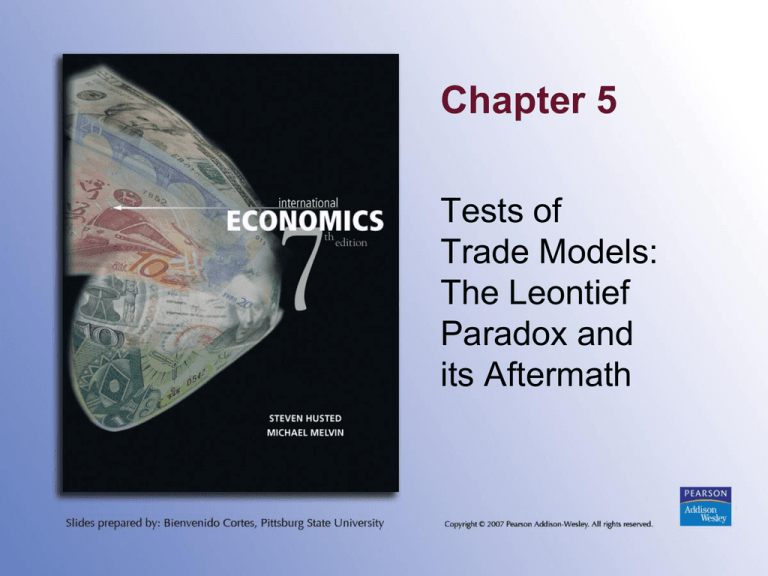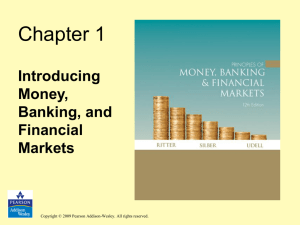
Chapter 5
Tests of
Trade Models:
The Leontief
Paradox and
its Aftermath
Topics to be Covered
•
•
•
•
•
•
•
•
•
•
Test of the Classical Model
Tests of the Heckscher-Ohlin Model
Leontief Paradox
Reconciliations of Leontief’s Findings
More Tests of the HO Model
Human Skills Theory
Product Life Cycle Theory
Similarity of Preferences Theory
Intra-industry Trade
Increasing Returns and Imperfect Competition
Copyright © 2007 Pearson Addison-Wesley. All rights reserved.
5-2
Test of the Classical Model
• G.D.A. MacDougall (1951)
• U.S. and U.K. exports and labor productivity
data for 25 industries in 1937
• Hypothesis: Since U.S. wages were twice
U.K. wages, then U.S. will have comparative
advantage in those industries where U.S.
labor is more than twice as productive as
U.K. labor.
• Finding: Hypothesis supported in 20 out of
25 industries.
Copyright © 2007 Pearson Addison-Wesley. All rights reserved.
5-3
Criticisms of the MacDougall Study
• Used U.S. and U.K. trade with rest
of the world instead of U.S.-U.K.
bilateral trade
• HO theory can also explain results
• Ignored other variables such as
transport costs, product differentiation,
and trade barriers
Copyright © 2007 Pearson Addison-Wesley. All rights reserved.
5-5
Test of the Heckscher-Ohlin Model
• W. Leontief (1951)
• Built input-output model for 200 U.S.
industries for 1947
• Assumed U.S. was the most Kabundant country
• Used U.S. exports and import
substitutes
Copyright © 2007 Pearson Addison-Wesley. All rights reserved.
5-6
Input-Output Table
• A table that details the sales of each industry
to all other industries in an economy.
• A spreadsheet with column entries showing
purchases made by a specific industry
from all other sectors, and row entries
showing sales by a specific industry to all
other sectors.
• Also contains the labor and capital
requirements for a fixed amount of output of
a given industry.
Copyright © 2007 Pearson Addison-Wesley. All rights reserved.
5-7
Leontief’s Test and Results
• Hypothesis: Since U.S. is K-abundant, the K/L
idled by a $1 million reduction in exports
would exceed the K/L required to produce $1
million of import substitutes.
• Results:
Reducing U.S. exports by $1 million idled $2.6
million in K and 182.3 worker years ($14,300K/wy).
Replacing $1 million of imports required $3.1
million in K and 170 worker years ($18,200K/wy).
Copyright © 2007 Pearson Addison-Wesley. All rights reserved.
5-8
Leontief Paradox
• The finding that U.S. exports tend to be
more labor-intensive than U.S. imports,
while U.S. imports are relatively more
capital-intensive than U.S. exports.
Copyright © 2007 Pearson Addison-Wesley. All rights reserved.
5-9
Reconciliations
of the Leontief Paradox
• U.S. workers are more productive than foreign
workers (Leontief)
• A third factor, natural resources, is not
considered (Vanek)
• U.S. tariffs on labor-intensive goods are
high (Travis)
• The identical tastes assumption is violated
• Leontief used data on U.S. importcompeting goods
Copyright © 2007 Pearson Addison-Wesley. All rights reserved.
5-10
Other Tests of the HO Model
• Leontief using 1951 data and Baldwin
using 1962 data found the paradox;
Stern and Maskus found no evidence.
• Paradox was also found in tests of
foreign countries (Japan, Canada, India).
• Results of tests on East Germany and
former Soviet Union were consistent with
HO theory.
Copyright © 2007 Pearson Addison-Wesley. All rights reserved.
5-11
More Recent Tests of HO Model
• Since the 1980s, more tests have been
conducted because:
Earlier studies were incomplete since these
did not link trade patterns with factor
endowments
Using a multifactor version of the HO
model, Leamer (1980) showed that trade
patterns and factor endowments were
related to each other
Copyright © 2007 Pearson Addison-Wesley. All rights reserved.
5-12
More Recent Tests (cont.)
• Two studies attempted to test the links
between endowments and intensities to
trade patterns:
Maskus (1985)
Bowen, Leamer, and Sveikauskas (1987)
• Both studies found contradictory results.
• Other studies which relaxed HO
assumptions had better results.
Copyright © 2007 Pearson Addison-Wesley. All rights reserved.
5-13
Alternative Theories
• Human Skills Theory
• Product Life Cycle Theory
• Similarity of Preferences Theory
Copyright © 2007 Pearson Addison-Wesley. All rights reserved.
5-14
Human Skills Theory
• Donald Keesing (1966)
• Emphasizes differences in
endowments and intensities of skilled
and unskilled workers.
• Explains the Leontief paradox:
Since the U.S. has highly trained,
educated workers relative to other
countries, U.S. exports tend to be
skilled-labor intensive.
Copyright © 2007 Pearson Addison-Wesley. All rights reserved.
5-15
Product Life Cycle Theory
• Raymond Vernon (1966)
• Comparative advantage may shift over time
from one country to another due to product
life cycle
• Stages of the cycle:
Product is invented and introduced in home country
Product becomes standardized
Foreign production begins
Comparative advantage lost to foreign firms
• Model has limited applicability
Copyright © 2007 Pearson Addison-Wesley. All rights reserved.
5-16
Similarity of Preferences Theory
• Stefan Linder (1961)
• Trade occurs among rich countries (with
similar standards of living) due to similar
tastes and product differentiation
• Linder’s theory applies only to differentiated
manufactured goods
• Linder finds nothing paradoxical about
Leontief’s finding
• The model explains intra-industry trade
• Evidence is mixed
Copyright © 2007 Pearson Addison-Wesley. All rights reserved.
5-17
Intra-industry Trade
• The simultaneous import and export of
similar types of products by a country.
• Examples: computers, cars, planes
Copyright © 2007 Pearson Addison-Wesley. All rights reserved.
5-18
Grubel-Lloyd Index
• A measure of intra-industry trade given by:
• The index ranges from zero to 100 with a
value of 100 indicating all trade of a country is
intra-industry.
• As shown in Table 5.3 following, countries
with the highest degree of intra-industry trade
are primarily industrialized countries.
Copyright © 2007 Pearson Addison-Wesley. All rights reserved.
5-19
Copyright © 2007 Pearson Addison-Wesley. All rights reserved.
5-20
If a Country Has Comparative Advantage in
a Good, Why Would the Country Import It?
• Transportation costs
• Data aggregation and categorization problems
• Increasing returns to scale and
imperfect competition
Copyright © 2007 Pearson Addison-Wesley. All rights reserved.
5-21
Increasing Returns to Scale
• Increasing returns to scale exist when a
proportionate increase in the use of all
inputs result in a greater than
proportional increase in output.
• If one or more industries in an economy
have increasing returns to scale, then
the country’s PPF will be convex in
shape (Refer to Figure 5.1 next)
Copyright © 2007 Pearson Addison-Wesley. All rights reserved.
5-22
Copyright © 2007 Pearson Addison-Wesley. All rights reserved.
5-23
Increasing Returns
and Gains from Trade
• Trade allows countries to specialize in,
and benefit from, industries with
increasing returns to scale
(Figure 5.2 on next slide)
Copyright © 2007 Pearson Addison-Wesley. All rights reserved.
5-24
Even with PS/PT
unchanged, there are
gains from trade.
also no
change in
W/R – less
disruption
Copyright © 2007 Pearson Addison-Wesley. All rights reserved.
5-25
Increasing Returns
and Imperfect Competition
• With increasing returns, the actions of
one firm can have effects on other firms.
• Imperfectly competitive markets
(monopolistic competition, oligopoly,
monopoly), rather than perfect
competition, prevail.
• Increasing returns to scale and
imperfect competition can explain
intra-industry trade (1/4 of world trade).
Copyright © 2007 Pearson Addison-Wesley. All rights reserved.
5-26
Monopolistic Competition and Trade
Trade with Increasing Returns and Monopolistic
Competition in Manufacturing (K intensive)
Home
(capital abundant)
Foreign
(labor abundant)
Manufactures
Food
Interindustry
trade
Intraindustry
trade
Main differences between interindustry and intra-industry trade
• The pattern of intra-industry trade itself
is unpredictable, whereas that of interindustry trade is determined by
underlying differences (comparative
advantage) between countries.
• The relative importance of intra-industry
and inter-industry trade depends on how
similar countries are.
Copyright © 2007 Pearson Addison-Wesley. All rights reserved.
5-28
Why Intra-industry Trade Matters
• Consumers gain more variety at a lower
prices than those that would prevail without
trade.
• Production is more efficient. (Larger market
allows full exploitation of economies of
scale.)
• When similar countries trade, the resulting
change in the income distribution (capital
v. labor) will be small
• Thus, everyone may gain from trade.
Conclusions
• The world is a very complicated place.
• Developing direct tests of international
trade models is difficult due to
restrictive assumptions, data, and
measurement problems.
• International economics is an
evolutionary science.
Copyright © 2007 Pearson Addison-Wesley. All rights reserved.
5-30
Chapter 5
Additional
Chapter Art
Copyright © 2007 Pearson Addison-Wesley. All rights reserved.
5-32







